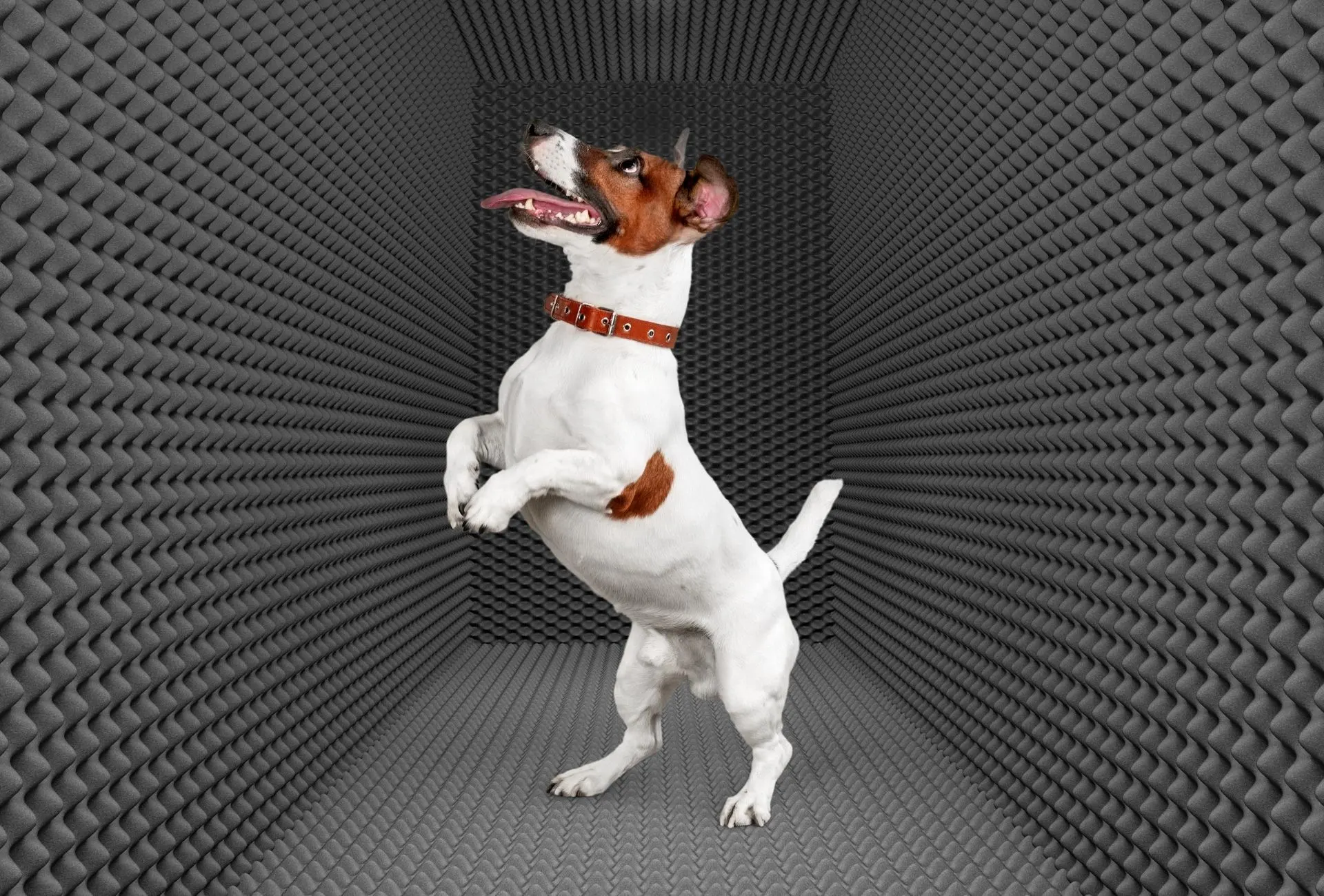If your canine buddy has a phobia of loud and unfamiliar noises or their non-stop barking is driving you and your neighbors crazy, the idea of soundproofing the dog crate may have crossed your mind.
Soundproofing helps reduce sounds and eliminate echoes while reducing the volume of your dog’s persistent barking.
It can also help dampen loud sounds in the crate which is particularly important for pets that are suffering from noise-related phobia and anxiety.
There are several ways to soundproof a dog crate.
A soundproof crate gives dogs a more comfortable place to stay in, while also reducing the noise inside your home.
For some dog owners, it’s the most viable solution.
But please keep in mind not to use the crate as a tool to avoid exercising or training your dog and excessive barking is a behavioral issue where the underlying issue needs to be resolved.
Can You Soundproof a Dog Crate?
Yes, soundproofing a dog crate is possible and while there’s no way to make a dog crate 100% soundproof, there are ways that noise can be significantly reduced.
The cost of the various soundproofing options differs, obviously the crème de la crème errs on the more expensive side.
However, some pet owners would willingly shell out extra bucks to address the problem and improve the quality of life for humans and pets alike.

Benefits of a soundproof crate:
- When a dog is relaxed, he is less likely to bark.
- Reduced barking and whining can help create a more peaceful home environment.
- If your dog is prone to noise-related phobia and anxiety, soundproofing protects your pet against noises that scare him.
- You won’t get in hot water with the neighbors for the noise that your dog is making.
But won’t my dog feel claustrophobic when inside a soundproof dog cage?
This is a common question that many pet owners share.
Take note that soundproofing materials are attached outside the crate or designed to cover the crate.
Thus, soundproofing won’t take away any space inside the crate.
Unfortunately, a dog crate can’t be 100% soundproof because it is nearly impossible to block out low-frequency sounds.
Soundproofing a crate for total silence would create an environment that’s too hot and uncomfortable for your dog.
How Can I Make My Dog’s Crate Quieter?
It is possible to make your dog’s crate quieter.
There are several options to choose from, each with its pros and cons.
The top dog crate soundproofing solutions are soundproof crate covers, absorption sheets, soundproof walls, blankets, soundproof curtains as well as a noise-canceling dog crate.
Soundproof Crate Covers
Soundproof crate covers are an inexpensive way for soundproofing dog crates.
It’s simply placed over the crate to cover it and to keep noise levels down.
These special crate covers come in various sizes.
When buying a crate cover, make sure that it’s made of breathable material so the inside of the crate won’t get too hot and uncomfortable for your dog.
Once the crate is covered, the level of sound getting in and out of the crate is significantly reduced.
Crate covers can easily be removed and are made of breathable and washable material.
An ideal dog crate cover doesn’t completely block out the light inside the crate.
The material should not reflect any sound. If your dog’s barking reflects off the crate cover, it will sound louder for the dog which compounds the problem.
Finding a crate cover that’s soundproof can be a challenge but a thick heavy-duty crate cover can be used for the purpose.
Some are designed to be dual-sided. The woven side is for heavy-duty use and the non-woven side for shielding items from environmental extremes.
Absorption Sheets
When it comes to addressing mid-high frequency sounds, absorption sheets are just right for the job.
The sheets can also reduce echoes.
Absorption sheets are inexpensive and they are made to easily fit the crate and be removed without using any tools. The sheets usually stick to the outside of the crate to create a barrier.
It’s a semi-permanent solution to soundproofing a dog’s crate. To ensure effectiveness, the sheets must fit your dog’s crate.
Compared to crate covers, sheets are better at reducing noise levels and are designed to fit specific measurements.
Placing absorption sheets inside the crate is not recommended because a dog can easily tear them apart.
Soundproof Dog Room Walls & Floor
If your dog hates staying inside his crate or he only barks when you’re out, you should consider soundproofing the walls and floor of the room where your pet stays.
Compared to other soundproofing options, this is more expensive but it’s a more permanent solution.
This option is ideal for larger dogs or those living in extremely noisy areas.
Soundproofing the walls and floor of your home can significantly reduce the sound inside the home thus creating a more comfortable environment for you and your dog.
Another possibility is that your dog hates being inside a crate or you’re not up to the idea of putting your pet inside a crate. Then you might consider soundproofing an entire room.
This will give your pooch more space to roam around and be comfortable.
Having more freedom to move around can help reduce a dog’s feelings of fear and anxiety when left home alone.
Soundproofing the walls and floor of the room where your dog stays might seem complicated.
The bigger the space that has to be soundproofed, the more materials it will need, and the more expensive it will be.
You may also need some professional assistance to make sure that the work is done correctly.
However, the expenses and the effort can certainly make a world of difference.
Some dog owners combine soundproofing of the dog room walls and floor with soundproofing of the dog crate.
Having a more quiet home and a happy dog is way better for everyone and is worth the investment.
Can Blankets Block Barking Sounds?
There are two types of blanket choices to block barking sounds:
Moving blankets.
The material that moving blankets are made of varies from that of regular blankets.
Also, moving blankets are designed to absorb noise and provide insulation.
You can simply put a moving blanket over your dog’s crate to block out noise.
When using a moving blanket, make sure your pet’s crate has adequate ventilation.
A crate that’s completely covered with a moving blanket may result in less breathing room for the dog.
Moving blankets are also inexpensive options for dog crate soundproofing.
Acoustic blankets.
Acoustic blankets are used to cover a dog crate and muffle a dog’s bark.
They have sound absorption and dampening properties. Their design and material reduce echo rather than block noise.
These blankets are also called soundproofing blankets, sound absorption blankets, or sound-dampening blankets.
Soundproof Curtains
Also called noise-blocking curtains or sound-deadening curtains, soundproof curtains are inexpensive and easy to install.
These special curtains are good for reducing echo inside the room however they are not effective in reducing the level of noise entering the room.
Without any echo, the sounds die out much more quickly, making the room quieter and more pleasing.
Soundproof curtains are made of porous material that can absorb sound waves.
They are heavy and thick since they’re designed to block out light and sound and provide thermal insulation.
Tips to remember when buying soundproof curtains:
- Density works best. If each window needs two panels, buy twice that number to create more density between the room and the window
- Curtains should be several inches longer and wider than the window
- Go for soundproof curtains that will go from ceiling to floor
- Use ceiling mount curtain brackets. The closer the curtain is to the ceiling, the more sound it blocks
- While I wouldn’t advise buying soundproof curtains made of polyester, other options include velvet or suede. The extra fibers of these textiles can help with soundproofing
- Thermal insulated curtains can also be efficient in absorbing sound and covering air gaps
Noise-Cancelling Dog Crate
The more expensive soundproof dog crates are made of sound-absorbing materials to absorb a dog’s barking.
The materials also lower echoes to decrease the degree of the barking.
These crates also have sound-dampening and vibration-dampening properties.

The more expensive soundproof crates are usually designed with an automatic fan to maintain good ventilation and create white noise.
They even come with a battery backup in case of power outages.
Many of these zen crates are still stuck in the funding and development phase though.
What To Look Out For When Soundproofing A Dog Crate
While you are working toward addressing your pet’s needs in soundproofing his crate, there are important factors that you should keep in mind. These include:
The heat inside the crate
To make sure that the temperature inside the crate remains comfortable for your dog, use a cover with a breathable material.
During the warmer months of the year, put the crate near a fan or inside an air-conditioned room.
Without proper ventilation and the right cover blanket, the temperature inside the crate could soar very quickly and this can cause discomfort and heat stress to your dog.
Crate position and ventilation
Place the dog crate in a part of the house away from heat-producing appliances and equipment such as the radiator.
Choose a place your dog is familiar with. For example, you could just place it where he’s usually staying when you’re away.
Also, the crate should not be exposed to direct sunlight. Proper ventilation is very important to keep the inside of the crate cool and comfortable.
Lighting inside the crate
Most dogs feel relaxed and secure inside a dark crate, more so when the dark crate is placed in a quiet area.
But completely blacking out the crate may cause confusion and stress for your dog.
Whether you go with soundproof crate covers or full-blown prepare the whole room; heat, position, ventilation, and lighting are key.
Your pet’s safety comes first and if you really want to get to the root of your dog’s barking, there’s only one solution.
Training and desensitization for anxious dogs.
Set the barking behavior on a speak and quiet command and make sure your dog is tired out before going into the crate.
Most dogs bark or destroy stuff cause they’re not exercised. Don’t be that dog owner. Trust me, your dog, neighbors, and wallet will thank you!
Disclaimer: This blog post does not substitute veterinary attention and does not intend to do so. I am not a veterinarian or pet nutritionist. If your dog shows any sign of illness, call your vet.